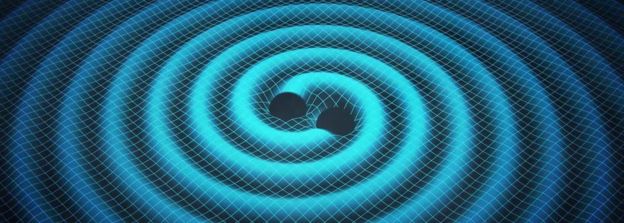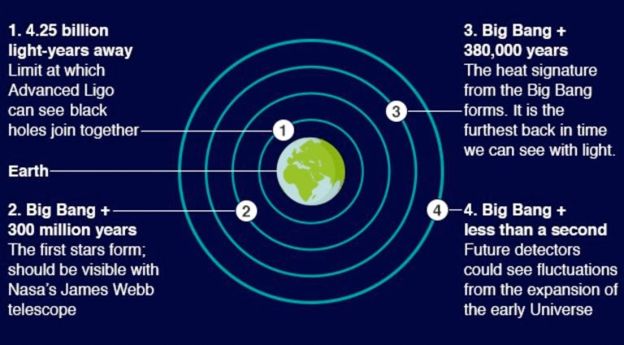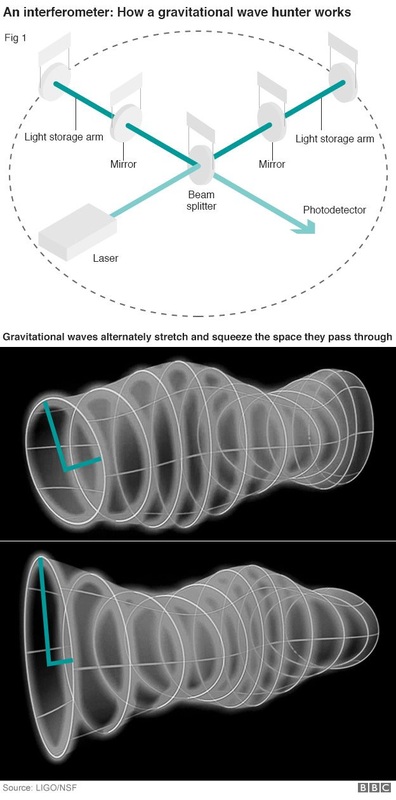
They have observed the warping of space-time generated by the collision of two black holes more than a billion light-years from Earth.
The international team says the first detection of these gravitational waves will usher in a new era for astronomy.
It is the culmination of decades of searching and could ultimately offer a window on the Big Bang.
The research, by the LIGO Collaboration, has been published today in the journalPhysical Review Letters.
The collaboration operates a number of labs around the world that fire lasers through long tunnels, trying to sense ripples in the fabric of space-time.
Gravitational waves: A triumph for big science
Expected signals are extremely subtle, and disturb the machines, known as interferometers, by just fractions of the width of an atom.
But the black hole merger was picked up by two widely separated LIGO facilities in the US.
The merger radiated three times the mass of the sun in pure gravitational energy.
"We have detected gravitational waves," Prof David Reitze, executive director of the LIGO project, told journalists at a news conference in Washington DC.
"It's the first time the Universe has spoken to us through gravitational waves. Up until now, we've been deaf."
- Gravitational waves are prediction of the Theory of General Relativity
- Their existence has been inferred by science but only now directly detected
- They are ripples in the fabric of space and time produced by violent events
- Accelerating masses will produce waves that propagate at the speed of light
- Detectable sources ought to include merging black holes and neutron stars
- LIGO fires lasers into long, L-shaped tunnels; the waves disturb the light
- Detecting the waves opens up the Universe to completely new investigations
"Gravitational waves provide a completely new way at looking at the Universe. The ability to detect them has the potential to revolutionise astronomy. This discovery is the first detection of a black hole binary system and the first observation of black holes merging," he said.
"Apart from testing (Albert Einstein's theory of) General Relativity, we could hope to see black holes through the history of the Universe. We may even see relics of the very early Universe during the Big Bang at some of the most extreme energies possible."
Team member Prof Gabriela González, from Louisiana State University, said: "We have discovered gravitational waves from the merger of black holes. It's been a very long road, but this is just the beginning.
"Now that we have the detectors to see these systems, now that we know binary black holes are out there - we'll begin listening to the Universe. "
On a graph, the data looks like a symmetrical, wiggly line that gradually increases in height and then suddenly fades away.
"We found a beautiful signature of the merger of two black holes and it agrees exactly - fantastically - with the numerical solutions to Einstein equations... it looked too beautiful to be true," said Prof Danzmann.Prof Sheila Rowan, who is one of the lead UK researchers involved in the project, said that the first detection of gravitational waves was just the start of a "terrifically exciting" journey.
"The fact that we are sitting here on Earth feeling the actual fabric of the Universe stretch and compress slightly due to the merger of black holes that occurred just over a billion years ago - I think that's phenomenal. It's amazing that when we first turned on our detectors, the Universe was ready and waiting to say 'hello'," the Glasgow University scientist told the BBC.
Being able to detect gravitational waves enables astronomers finally to probe what they call "dark" Universe - the majority part of the cosmos that is invisible to the light telescopes in use today.
Perfect probeNot only will they be able to investigate black holes and strange objects known as neutron stars (giant suns that have collapsed to the size of cities), they should also be able to "look" much deeper into the Universe - and thus farther back in time. It may even be possible eventually to sense the moment of the Big Bang.
"Gravitational waves go through everything. They are hardly affected by what they pass through, and that means that they are perfect messengers," said Prof Bernard Schutz, from Cardiff University, UK.
"The information carried on the gravitational wave is exactly the same as when the system sent it out; and that is unusual in astronomy. We can't see light from whole regions of our own galaxy because of the dust that is in the way, and we can't see the early part of the Big Bang because the Universe was opaque to light earlier than a certain time.
"With gravitational waves, we do expect eventually to see the Big Bang itself," he told the BBC.
In addition, the study of gravitational waves may ultimately help scientists in their quest to solve some of the biggest problems in physics, such as the unification of forces, linking quantum theory with gravity.
At the moment, General Relativity describes the cosmos on the largest scales tremendously well, but it is to quantum ideas that we resort when talking about the smallest interactions. Being able to study places in the Universe where gravity is really extreme, such as at black holes, may open a path to new, more complete thinking on these issues.
- A laser is fed into the machine and its beam is split along two paths
- The separate paths bounce back and forth between damped mirrors
- Eventually, the two light parts are recombined and sent to a detector
- Gravitational waves passing through the lab should disturb the set-up
- Theory holds they should very subtly stretch and squeeze its space
- This ought to show itself as a change in the lengths of the light arms (green)
- The photodetector captures this signal in the recombined beam
Einstein himself actually thought a detection might be beyond the reach of technology.
His theory of General Relativity suggests that objects such as stars and planets can warp space around them - in the same way that a billiard ball creates a dip when placed on a thin, stretched, rubber sheet.
Gravity is a consequence of that distortion - objects will be attracted to the warped space in the same way that a pea will fall in to the dip created by the billiard ball.
Inspirational momentEinstein predicted that if the gravity in an area was changed suddenly - by an exploding star, say - waves of gravitational energy would ripple across the Universe at light-speed, stretching and squeezing space as they travelled.
Although a fantastically small effect, modern technology has now risen to the challenge.
Much of the R&D work for the Washington and Louisiana machines was done at Europe's smaller GEO600 interferometer in Hannover.
"I think it's phenomenal to be able to build an instrument capable of measuring [gravitational waves]," said Prof Rowan.
"It is hugely exciting for a whole generation of young people coming along, because these kinds of observations and this real pushing back of the frontiers is really what inspires a lot of young people to get into science and engineering."



 RSS Feed
RSS Feed